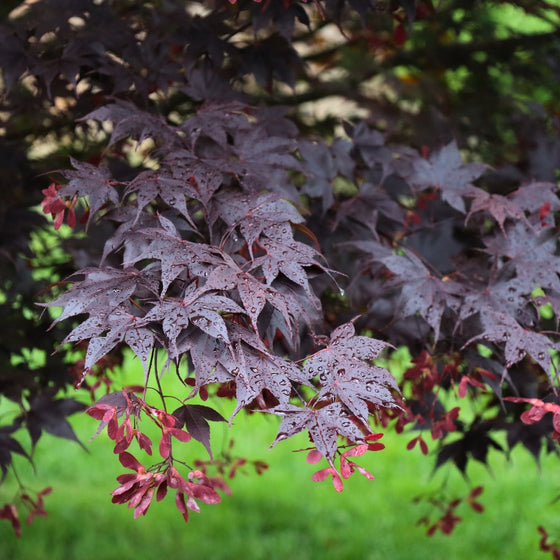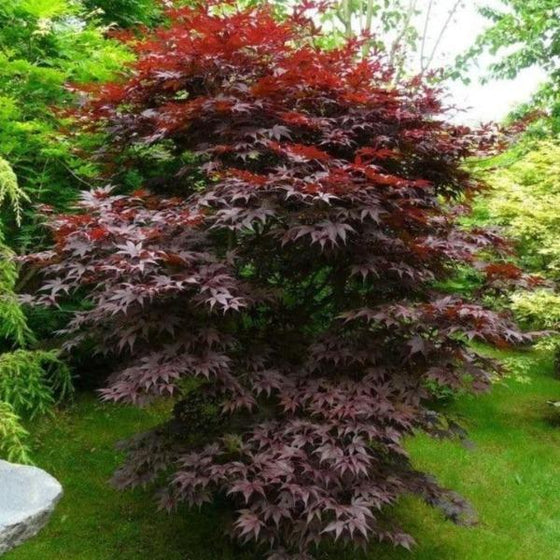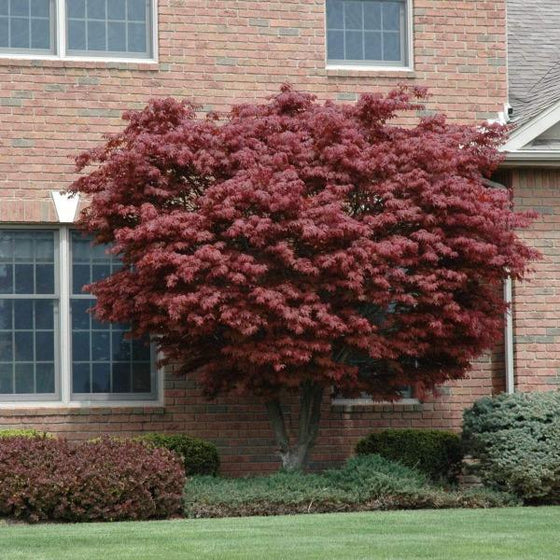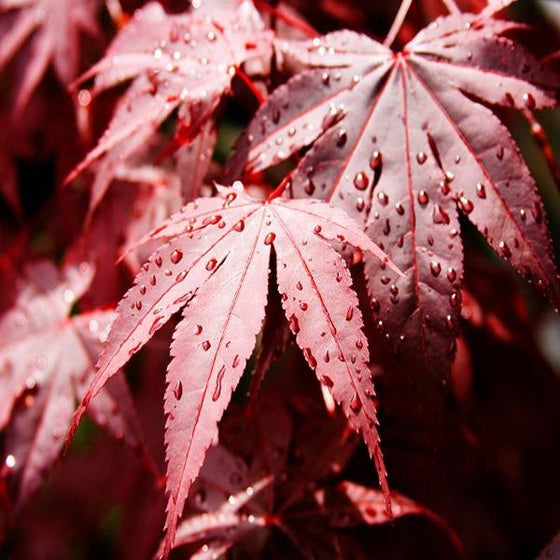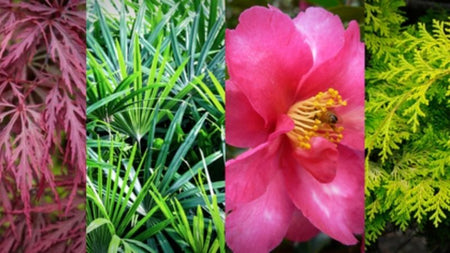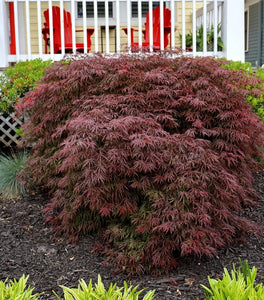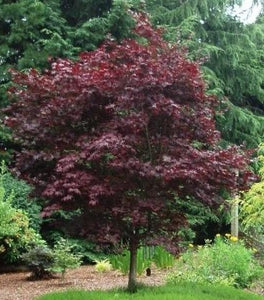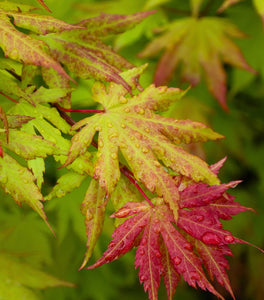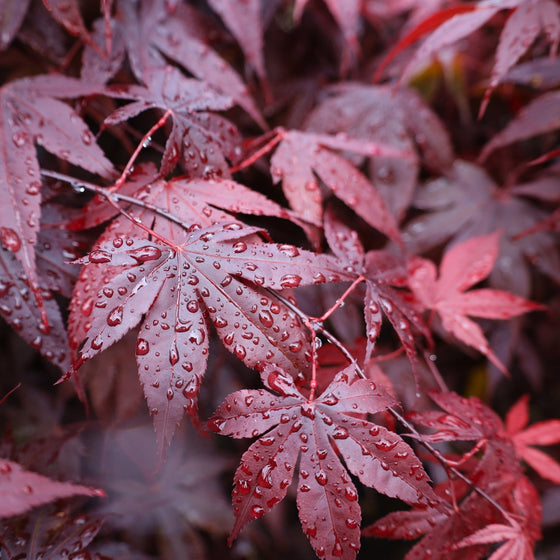
Images Depict Mature Plants
Bloodgood Japanese Maple Trees
Bloodgood Japanese Maple (Acer palmatum ‘Bloodgood’) is one of the most iconic and beloved Japanese maple varieties, celebrated for its stunning deep red foliage and elegant, upright form. In spring, the finely cut leaves emerge a vibrant burgundy-red, retaining their rich color through the summer before transitioning to brilliant crimson tones in the fall. With its graceful branching structure and year-round interest, Bloodgood provides a striking focal point in gardens, patios, and landscape designs. Typically growing 15 to 20 feet tall and wide, this moderate-sized ornamental tree is perfect for creating shade, adding color, or enhancing the beauty of mixed borders and woodland gardens.
Thriving in partial sun to partial shade, Bloodgood Japanese Maple prefers well-drained, slightly acidic soil to maintain its vivid foliage color and healthy growth. In cooler climates, it can tolerate full sun with adequate watering, while in warmer regions, some afternoon shade helps protect the delicate leaves from scorching. Its moderate growth rate, low-maintenance care requirements, and exceptional hardiness make Bloodgood a favorite among gardeners and landscape designers. Whether planted as a specimen tree, used along walkways, or showcased in large containers, its dramatic color and refined form add elegance and timeless beauty to any setting.
Perfect for four-season landscapes, Bloodgood Japanese Maple also offers striking winter interest with its dark, sculptural branches standing out against the snowy backdrop. Its adaptability to a variety of soil types and growing conditions makes it a versatile choice for both formal and informal gardens. Whether you are designing a serene Japanese-inspired retreat or simply adding a bold accent to your yard, Bloodgood Japanese Maple delivers unmatched color, structure, and style year after year.
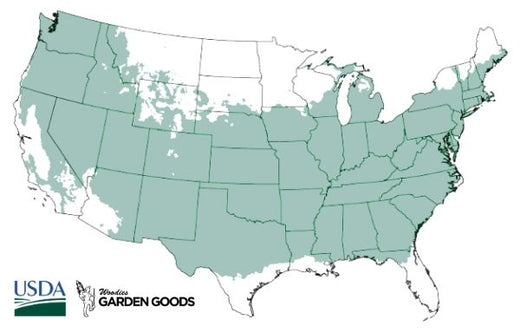
| Hardiness Zone: | 5 - 8 |
|---|---|
| Mature Height: | 15 to 20 feet |
| Mature Width: | Up to 15 to 20 feet |
| Classification: | Small tree |
| Sunlight: | Full Sun to part shade |
| Habit: | Deciduous |
| Foliage: | Burgundy red foliage that turns brilliant scarlet in fall |
| Soil Condition: | Any well drained soil |
| Water Require: | Water well until established |
| Uses: | Extremely attractive when used as a focal point or a specimen planting. |
How to Care for Bloodgood Japanese Maple
Before you buy a Bloodgood Japanese Maple Tree, make sure to read about the recommended care instructions to keep this plant healthy and thriving.
How do I Plant my Bloodgood Japanese Maple Tree?
To plant your Bloodgood Japanese Maple tree successfully, choose a location with partial sun to partial shade, ensuring it receives morning sun and protection from intense afternoon heat, especially in warmer climates. The soil should be rich, well-drained, and slightly acidic to neutral for the best growth and vibrant foliage color. Dig a hole twice as wide and just as deep as the tree’s root ball, positioning the top of the root ball slightly above ground level to promote good drainage. Gently loosen any circling roots, place the tree into the hole, and backfill with a mix of native soil and organic compost to encourage healthy root development. Water thoroughly after planting to settle the soil and remove air pockets. After planting your Bloodgood Japanese Maple, apply a 2- to 3-inch layer of organic mulch, such as shredded bark or leaf mold, around the base of the tree, keeping the mulch a few inches away from the trunk to prevent rot. Mulching helps retain soil moisture, regulate temperature, and suppress weeds, all of which support healthy, vigorous growth. During the first growing season, water consistently to keep the soil evenly moist but not soggy. With proper planting and site selection, your Bloodgood Japanese Maple will establish quickly, rewarding you with its stunning deep red foliage, graceful form, and four-season beauty in your garden or landscape.
How do I Water my Bloodgood Japanese Maple Tree?
Watering your Bloodgood Japanese Maple properly is essential for supporting healthy growth, maintaining vibrant red foliage, and developing a strong root system. During the first growing season, water deeply two to three times per week to ensure the soil remains consistently moist but not waterlogged. Focus on deep, slow watering at the base of the tree rather than frequent shallow watering, which can lead to weak surface roots. Using a soaker hose or drip irrigation system is ideal, as it provides steady moisture directly to the root zone while minimizing the risk of fungal issues on the foliage. Once established, your Bloodgood Japanese Maple will require less frequent watering but will still benefit from deep soakings during hot, dry periods, especially in summer. Always check the top few inches of soil—if it feels dry, it’s time to water thoroughly. Applying a 2–3 inch layer of organic mulch around the base helps conserve soil moisture, regulate root zone temperature, and reduce watering needs. Proper, consistent watering ensures your Bloodgood Japanese Maple remains healthy, vibrant, and able to showcase its brilliant seasonal color and elegant form year after year in your landscape.
How do I Fertilize my Bloodgood Japanese Maple Tree?
Fertilizing your Bloodgood Japanese Maple properly is important for maintaining its vibrant red foliage, promoting steady growth, and ensuring long-term tree health. In early spring, before new growth emerges, apply a slow-release, balanced fertilizer such as a 10-10-10 formula or one specifically formulated for Japanese maples and ornamental trees. Spread the fertilizer evenly around the drip line of the tree, taking care to keep it several inches away from the trunk, and water thoroughly after application to help the nutrients reach the roots. Avoid high-nitrogen fertilizers, which can encourage excessive leafy growth at the expense of the tree’s elegant structure and brilliant color. For continued vitality, supplementing with organic materials like compost, well-aged manure, or finely shredded mulch can help maintain a rich, slightly acidic soil environment that Bloodgood Japanese Maples prefer. If your tree is planted in particularly sandy or poor soil, a second, lighter feeding in mid-summer can be beneficial. Always fertilize conservatively, as overfeeding can stress the tree and reduce foliage quality. With a consistent and thoughtful fertilization schedule, your Bloodgood Japanese Maple will thrive, displaying breathtaking red foliage in spring and summer and fiery crimson hues in the fall, making it a stunning focal point in any landscape.

How and when should I Prune my Bloodgood Japanese Maple Tree?
Pruning your Bloodgood Japanese Maple should be done carefully to enhance its natural, elegant form and promote healthy growth. The best time to prune is in late winter to early spring, just before new leaf buds begin to swell but after the threat of severe frost has passed. Start by removing any dead, damaged, or crossing branches using clean, sharp pruning shears. Light thinning of dense interior branches helps improve air circulation and allows more light to reach the interior canopy, supporting vibrant foliage and reducing the risk of fungal diseases. Always make precise cuts just above a bud or branch junction to encourage healthy, natural regrowth. You can also perform light touch-up pruning in early summer after the new leaves have fully emerged, which allows you to fine-tune the tree’s shape while minimizing stress. Avoid heavy pruning in late summer or fall, as this can stimulate tender new growth that may not harden off before winter. When pruning your Bloodgood Japanese Maple, the goal is to preserve its beautiful, layered branching structure and graceful silhouette. With careful, minimal pruning each year, your Bloodgood will maintain its striking red foliage, refined shape, and standout presence in your garden or landscape for decades to come.

